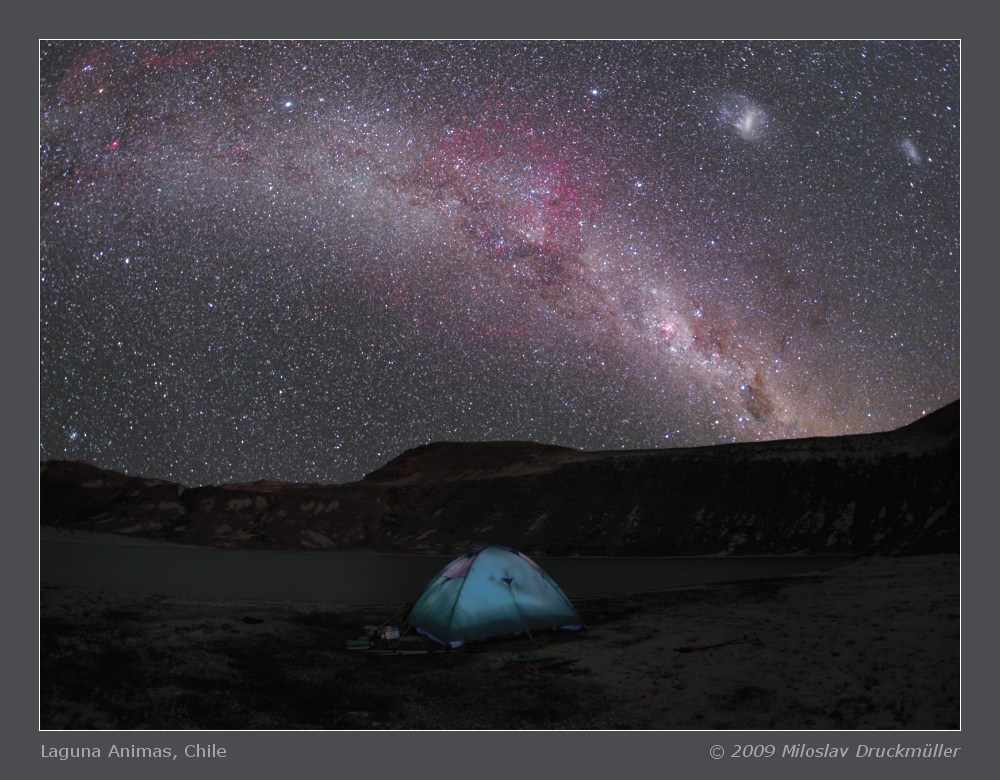
Milky Way over Laguna Animas
This image was in my mind more than one year.
Laguna Animas is a charming mountain lake, which was
visited for the first time by my wife Zuzana and me in 2008 during our Chilean mountaineering
expedition. We were enamoured by this
beautiful piece of Andean landscape. Starry night on the bank
of this lake was an unforgettable experience. The altitude of 2276 m and absence of light pollution
makes this place a dream observing place for a poor inhabitant of a big city in central Europe. A
"small" problem is that the observing place is about 8 hours of walking far from the
nearest place accessible by bus or by car. Moreover, I had to carry all my photographic equipment in my
backpack
during the whole one month expedition. Therefore my equipment was limited to Canon EOS
5D, Tamron lenses 17-35 mm, 28-75 mm, 70-300 mm, Zeiss Flektogon 2.8/20 mm and
Canon Fisheye 15 mm - fix focal length lenses with the infinity stop for night photography and a
small tripod. During walking or climbing, very often I blasphemed myself for the foolish idea to take
so much equipment. Conversely, during the nights I suffered that I have no better equipment.
Mountain climbing and astrophotography is really a painful combination. I took numerous nocturnal
images (including comet Holmes)
during our 2008 expedition. Some of them turned out rather well but
the unmodified Canon with its very low red sensitivity was not able to manage the job. This brought
me to following a crazy idea.
I bought a
bigger backpack for our 2009 Chilean
expedition and I added one heavy piece more to my heavy equipment - a modified Canon EOS 5D body. The
visit of Laguna Animas was not in our preliminary plans, however bad weather in Patagonia changed
our plans. I got the second chance after one year.
The resulting image is a
composition of totally 58 images. Moreover about hundred other images were used as dark
frames and images for geometrical calibration. The camera equipped with 15 mm fisheye was
directed to four different direction. The "master" image on which all other images were
aligned was taken at 22:16 of local time. It was necessary to overcome two main problems -
impossibility of taking flat-field images for fisheye and finding acceptable geometrical transform
for an image with nearly 180° diagonal field of view. Finally the result is highly over my
expectations and as for me worth dragging the heavy camera body. The image in this page
is optimized for viewing in darkness. You may see brighter image versions here
(small, big). An image with
boundaries of constellations and bright stars captions is
here.
I stopped taking images of the sky at about
23:30 of local time for strong wind. This wind changed to heavy windstorm during a short time
and so I spent the rest of the night leaned against the windward side
of our tent.
Click on the image or on the following reference to display the
higher resolution image version (3.7 MB, PNG format).
|
| Image | Animas_w1.jpg |
| Date | 19. 01. 2009 |
| Time | 22:16 of local time |
| Place | Laguna Animas, NP Radal Siete Tazas, Chile |
| Coordinate | S 35° 29.026', W 70° 50.903', Alt. 2276 m |
| Optics | Canon Fisheye lens EF 15mm 1:2.8 |
| Camera | Canon EOS 5D (Hutech Ia modification) |
| Exposure | 58× 30 s (ISO 3200) |
| Copyright | © 2009 Miloslav Druckmüller |
|
Miloslav Druckmüller
Institute of Mathematics, Faculty of Mechanical Engineering
Brno University of Technology, Czech Republic
druckmuller@fme.vutbr.cz
|
Page last update: 11.3.2009
|
|

